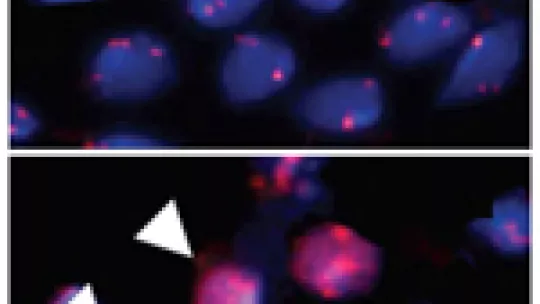Images
Researchers at IRB Barcelona discover a crucial mechanism controlling the segregation of genetic material from parent to daughter cells. A finely tuned process of degradation tightly regulates CenH3 protein levels to ensure the correct function of the cell division machinery in Drosophila.
From bacteria to humans, all forms of life are based on the capacity of one cell to divide into two or more identical daughter cells. In doing so, cells have to produce a copy of their genetic material (DNA) and separate it into two identical sets, one for each daughter cell. Immediately after duplication and before its segregation, DNA is packed in chromosomes that consist of two identical strands joined at a point along their length, called centromeres. Centromeres ensure accurate separation of the chromosomes between daughter cells by directing the assembly of the molecular scaffolding that helps separate cells. The group of scientists led by the IBMB-CSIC Professor and IRB Barcelona researcher Ferran Azorín has identified the main instrument that Drosophila cells use to control the levels of the CenH3 protein, a key element for defining the identity and function of the centromere in the fruit fly.
CenH3 is a unique variant of conventional histones —proteins responsible for DNA packaging— found exclusively in the centromeres of all eukaryotes studied to date. “The presence of CenH3 in chromosome regions other than the centromere is sufficient to cause defects in chromosome separation in Drosophila and in budding yeast”, explains Azorín. In yeast and Drosophila, the controlled degradation of CenH3 is known to be one of the mechanisms that regulate its location in the centromere. How this mechanism works, however, has been a mystery until now. The study, led by Azorín and published online on August 25 in Current Biology, shows that CenH3 interacts specifically with the protein partner of pair (Ppa), involved in directing proteins toward degradation. “We have demonstrated that degradation of CenH3 is essential for limiting its presence at the centromeres and that this degradation is mediated by the protein Ppa, which targets CenH3 to one of the cell’s degradation mechanisms, the proteasome”, explains Azorín. The proteasome is a barrel-shape protein structure that breaks down and disposes of unfunctional or unnecessary proteins in the cell. When a protein has to be degraded it needs to be somehow ‘tagged’ for degradation so it can be detected efficiently and directed to the proteasome. Ppa is part of a ‘degradation labelling complex’ that marks proteins such as CenH3 with a molecule called ubiquitin for destruction in the proteasome.
“The split between insects and humans during evolution must have occurred about 5 hundred millions years ago. However, most of the molecular components of the centromere have remained practically unchanged in all eukaryotic organisms: CenH3, for example is found in all eukaryotic centromeres”, says Azorín. In Drosophila and also in humans impairment of chromosome segregation during cell division may contribute to disease and birth defects. Thus, errors in centromere function can lead to chromosome instability and aberrant cell division, both of which are often observed in cancer cells. Given the essential roles of the centromeric CenH3 during cell division and the similarities in centromeric structure and function observed among all eukaryotes, the insights into Drosophila centromere stability provided by Azorín’s group may contribute to our understanding of the genetic basis of cancer.
Reference article:
The F-box protein partner-of-paired (Ppa) regulates stability of Drosophila centromeric histone H3, CenH3CID
Olga Moreno-Moreno, Sònia Medina-Giró, Mònica Torras-Llort and Fernando Azorín
Current Biology DOI 10.1016/j.cub.2011.07.041
About IRB Barcelona
The Institute for Research in Biomedicine (IRB Barcelona) pursues a society free of disease. To this end, it conducts multidisciplinary research of excellence to cure cancer and other diseases linked to ageing. It establishes technology transfer agreements with the pharmaceutical industry and major hospitals to bring research results closer to society, and organises a range of science outreach activities to engage the public in an open dialogue. IRB Barcelona is an international centre that hosts 400 researchers and more than 30 nationalities. Recognised as a Severo Ochoa Centre of Excellence since 2011, IRB Barcelona is a CERCA centre and member of the Barcelona Institute of Science and Technology (BIST).





